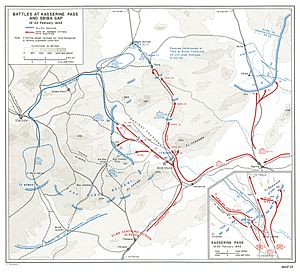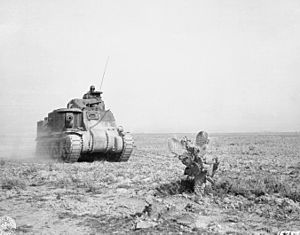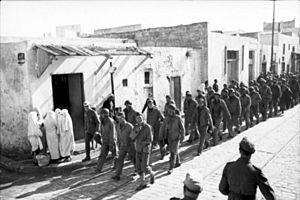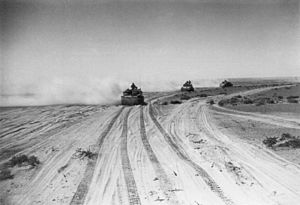Battle of Kasserine Pass facts for kids
Quick facts for kids Battle of Kasserine Pass |
|||||||
|---|---|---|---|---|---|---|---|
| Part of the Tunisian campaign of World War II | |||||||
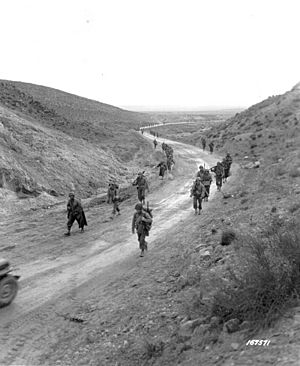 Men of the 2nd Battalion, 16th Infantry Regiment of the U.S. 1st Infantry Division march through the Kasserine Pass and on to Kasserine and Farriana, Tunisia February 26, 1943. |
|||||||
|
|||||||
| Belligerents | |||||||
| Commanders and leaders | |||||||
| Strength | |||||||
| 30,000 | 22,000 | ||||||
| Casualties and losses | |||||||
3,300 killed and wounded 3,000 POWs 183 tanks lost 616 vehicles lost 208 guns lost (Including Sidi Bou Zid) 500 killed and wounded Total: 10,000 casualties |
989 killed or wounded 608 captured 20 tanks lost 67 vehicles lost 14 guns lost (Including Sidi Bou Zid) |
||||||
The Battle of Kasserine Pass was a major battle during World War II. It happened in February 1943 in Tunisia, North Africa. This battle was the first big fight between American and German forces in the war.
The battle took place at Kasserine Pass, a narrow gap in the Atlas Mountains. The Axis forces, mainly from Germany and Italy, were led by General Erwin Rommel. The Allied forces included soldiers from the United States, Britain, and France.
At first, the American troops were new to fighting. They were pushed back by the experienced Axis forces. Many Allied soldiers were hurt or captured. However, Allied reinforcements soon arrived. They used strong artillery (big guns) to stop the Axis advance.
The Axis forces were spread too thin and faced strong counterattacks. They also faced attacks from Allied planes. Because of this, they had to retreat from Kasserine Pass by February 24. This battle taught the Allies important lessons. The U.S. Army made big changes to how its units were organized and how they fought. Some commanders were also replaced.
Why the Battle Happened
Allied Landings in North Africa
In November 1942, American and British forces landed in French Morocco and Algeria. This operation was called Operation Torch. It happened shortly after British forces won a big battle in Egypt.
In response, German and Italian troops quickly moved into Tunisia. Tunisia was a good place to defend in North Africa. It was also very close to their bases in Sicily. This made it hard for Allied ships and planes to stop Axis supplies from reaching Tunisia.
The Race for Tunis
The Allies tried to reach Tunis, the capital of Tunisia, quickly. This was called the "Run for Tunis." They wanted to get there before Germany and Italy could send more soldiers. However, the roads and railways were poor. Only a small Allied force could be supplied.
The Germans and Italians used the tough terrain to their advantage. They stopped the Allied advance. More Allied planes and airfields were built. This helped to slow down the flow of Axis troops and equipment. But a large Axis force was already in Tunisia.
Rommel's Plan
By January 1943, the British Eighth Army captured Tripoli. This was General Rommel's main supply base. Rommel had already planned for this. He moved his supply lines to Tunis. His goal was to block the southern path into Tunisia.
Allied troops had crossed the Atlas Mountains. They set up a base at Faïd. This was a great spot to attack the coast. It could split the Axis forces in two. Rommel decided to attack the Allies first.
Leading Up to the Battle
Faïd Pass
On January 30, 1943, German forces attacked Allied positions at Faïd. French troops fought bravely but were pushed back. American tanks and artillery joined the fight. They destroyed some German tanks. The remaining German tanks seemed to retreat.
However, this was a trap. When the American tanks chased them, they ran into hidden German anti-tank guns. Many American tanks were destroyed. The Germans continued their attack. American soldiers suffered heavy losses. They were often in shallow holes, which German tanks could easily crush.
The Germans captured most of Tunisia. The Allies held the middle part of the Atlas Mountains. But the exits were blocked. For the next two weeks, Rommel and other Axis commanders planned their next move.
Sidi Bou Zid
Rommel believed the British Eighth Army was not a big threat yet. So, he proposed attacking American supply bases in Algeria. This would capture supplies and stop the U.S. from gathering its forces.
On February 14, German forces attacked Sidi Bou Zid. This started the Battle of Sidi Bou Zid. American tanks were defeated. The infantry was spread out and could not help each other. A counterattack by the Americans failed. On February 16, the Germans moved towards Sbeitla.
Because of the threat, the Allies pulled back from the eastern mountains. They moved to the western mountains near Kasserine and Sbiba Passes. American losses were high: 2,546 men, 103 tanks, and many other vehicles and guns.
Axis Attack Plan
After these successes, the Axis leaders argued about what to do next. Rommel wanted to attack through Kasserine Pass. His goal was to reach the main U.S. forces at Tébessa. He wanted to capture U.S. supplies and prevent the Allies from attacking the coast.
On February 19, Rommel's plan was approved. He would get more German tank divisions. They would attack through Kasserine and Sbiba passes. This would clear the western mountains and threaten the British First Army. Rommel was worried this plan would spread his forces too thin. He preferred a strong attack on Tébessa.
The Battle Begins
In the early morning of February 19, Rommel ordered his forces to attack Kasserine Pass. Other German divisions were ordered to attack north through the pass towards Sbiba.
Sbiba
German forces attacked the Sbiba area. They faced British and American troops. The Allies had strong defenses and minefields. The Germans made little progress. By February 20, the German attack was stopped and pushed back.
Kasserine
American and French forces defended Kasserine Pass. They had infantry, engineers, artillery, and tank destroyers. On February 18, Colonel Alexander Stark took command of these forces.
An early German attempt to surprise the defenders failed. German infantry and tanks then attacked slowly. Rommel decided to commit more tanks from the 10th Panzer Division the next morning. They would attack with the Italian 131st Armored Division. British reinforcements were also arriving.
On the night of February 19, German forces took over the hills overlooking the pass. On February 20, German and Italian soldiers attacked again. The Italian 5th Bersaglieri Regiment made a direct attack on American positions. They captured the position, opening the road to Thala and Tebessa. By midday, Axis tanks poured through the pass. This was one of the worst U.S. defeats in the Tunisian Campaign. The Italian regiment was praised for its actions. By the afternoon, the Axis forces broke through the defenses. American survivors retreated in disarray.
Djebel el Hamra
On February 21, German and Italian forces moved towards Haidra and Tebessa. They met American defenders at Djebel el Hamra. The Axis attack was stopped. Despite heavy pressure and air attacks, they could not move the Americans.
On February 22, the Axis forces launched another attack. But the American line held firm. By mid-afternoon, American infantry and tanks counterattacked. They broke the German and Italian forces. More than 400 Axis soldiers were captured.
Thala
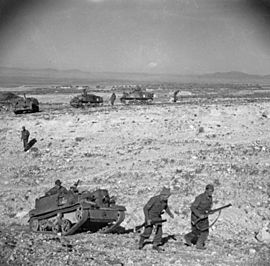
Rommel stayed with the main German tank division heading towards Thala. British and American troops had dug in on ridges there. If Thala fell, American forces to the north would be cut off.
The combined Allied forces fought a costly delaying action. They slowly retreated ridge by ridge. By dark, they held the German attacks just south of Thala. American and British artillery arrived that night. The next day, the front was held by British infantry. They had very strong support from American and British artillery.
On February 22, an intense artillery barrage from the Allied guns stopped the German attack. It destroyed tanks and vehicles. The German commander decided to pause and regroup. But Allied reinforcements kept arriving. The German forces waited until dark to leave the battlefield.
Axis Withdrawal
Rommel's forces were spread too thin. Their supplies were running low. Allied artillery was pinning them down. American counterattacks were also happening. Rommel realized his forces were exhausted.
He decided it was better to pull back. He wanted to focus on fighting the British Eighth Army in southern Tunisia. On February 23, Rommel met with other commanders. They tried to convince him to keep fighting. But Rommel insisted on retreating.
Formal orders were given that evening to call off the attack. All Axis units were told to return to their starting positions. On February 23, a huge American air attack on the pass sped up the German retreat. By late February 24, the Allies had retaken the pass. Feriana, Sidi Bou Zid, and Sbeitla were also back in Allied hands.
What Happened After
Losses in the Battle
The Battle of Kasserine Pass resulted in significant losses for both sides.
- German losses: 201 killed, 536 wounded, and 252 missing. They lost 20 tanks, 67 vehicles, and 14 guns.
- Allied losses: The U.S. lost 300 killed, 3,000 wounded, and 3,000 missing. French losses were 50 killed, 200 wounded, and 250 missing. In total, about 10,000 Allied soldiers were casualties.
- Equipment losses: The U.S. lost 183 tanks, 104 half-tracks, 208 guns, and 512 trucks. The Germans captured some of this equipment. The Allies also lost a lot of fuel and ammunition.
Lessons Learned
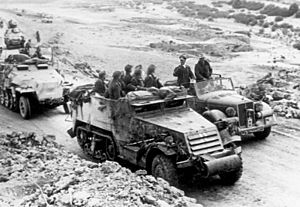
Rommel had hoped to take advantage of the new Allied commanders' inexperience. He later noted how quickly U.S. commanders learned about mobile warfare. He also praised American equipment, especially the strong M3 half-track. German units used many captured U.S. vehicles after the battle.
The Allies also learned important lessons.
- Positioning: U.S. forces were often too far apart to help each other. Commanders had not personally checked the ground.
- Digging in: Soldiers were sometimes careless about digging deep foxholes. This made them easy targets.
- Air superiority: The Allies could not stop German planes from controlling the skies. This limited Allied air patrols. German bombing and strafing attacks disrupted Allied movements.
- Coordination: Artillery and air support were not well coordinated.
Changes in Command
General Dwight D. Eisenhower began to change the Allied command structure. He created the 18th Army Group. This group was led by General Sir Harold R. L. G. Alexander. Its purpose was to improve control and coordination among the Allied nations.
Major General Lloyd Fredendall was replaced by Eisenhower and sent home. Eisenhower learned that Fredendall's officers had lost faith in him. Other commanders were also removed or moved to different roles.
General George Patton was temporarily put in charge of the U.S. II Corps. Patton was known for taking action quickly. He did not hesitate to support his troops. Efforts were made to improve artillery and air support. American anti-aircraft artillery also made changes. They learned that field units needed special guns to protect them from air attacks.
See also
 In Spanish: Batalla del paso de Kasserine para niños
In Spanish: Batalla del paso de Kasserine para niños
- List of equipment of the United States Army during World War II
- List of British military equipment of World War II
- List of French military equipment of World War II
- List of German military equipment of World War II
- List of Italian Army equipment in World War II
- List of World War II battles
- North African campaign timeline
- Panzer Army Africa



